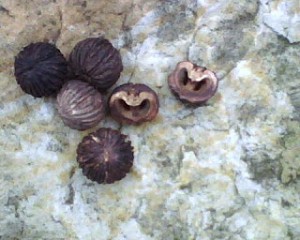Hey, if you’re already putting the money into a 1938 Rolls-Royce, go right ahead and deck out the body in Nogal.
Trade Name: Nogal, Peruvian walnut, South American walnut, Andean walnut
Genus: Juglans neotropica
Janka Hardness (pounds-force): 1080
Description: Peruvian walnut, or Nogal, is darker than its North American cousin Black walnut, and its sapwood doesn’t have the light cream coloring. Peruvian Walnut is a deep brown, with a sometimes purple hue to it. It’s relatively soft, and is an evergreen species. The texture is course, the pores are average, and the grain is straight to irregular. Nogal is the Spanish translation for walnut. Peruvian walnut may be marketed as many species of the Genus Juglans, but the specifications listed here apply to the species neotropica.
Location: Central and South America
Common Aliases: South American nogal, Nogal, South American walnut.
Performance: Generally easier to work than North American walnut. The wood can be found with lighter streaks in some of the stock, and is sometimes dyed. Grain is fairly regular, texture is coarse, and the pores are medium. Peruvian walnut fares above average against insect attack. Still, if forced to choose, I choose indoor application for this species.
Or a snack. Look tasty? You can buy the fruits from Juglans neotropica here.
Common Uses: Food, Musical instruments, carvings, decorative objects, flooring, furnishings, cabinetry, pens, plywood, veneers, turnings.
From: The Wood Database:
Common Name(s): Peruvian Walnut, Tropical Walnut, Nogal
Scientific Name: Juglans spp. (Juglans neotropica, J. olanchana, etc.)
Distribution: Southern Mexico, Central and South America
Tree Size: 30-60 ft (9-18 m) tall, 2-3 ft (.6-1.0 m) trunk diameter
Average Dried Weight: 38 lbs/ft3 (610 kg/m3)
Basic Specific Gravity: .50
Hardness: 1,080 lbf (4,800 N)
Rupture Strength: 10,020 lbf/in2 (69,080 kPa)*
*Estimated bending strength from data of 15% MC wood at: 9,100 lbf/in2 (62,760 kPa)
Elastic Strength: 1,055,000 lbf/in2 (7,280 MPa)*
*Estimated elasticity from data of 15% MC wood at: 1,020,000 lbf/in2 (7,030 MPa)
Crushing Strength: 5,920 lbf/in2 (40.8 MPa)*
*Estimated crushing strength from data of 15% MCwood at: 5,180 lbf/in2 (35.7 MPa)
Shrinkage: Radial: 2.8%, Tangential: 5.5%, Volumetric: 8.3%, T/R Ratio: 2.0

